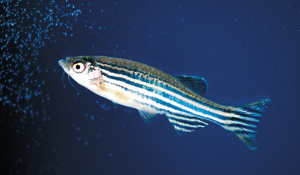 The past decade has seen an increasing trend of Zebrafish usage in biomedical research leading to increased pressure on animal technicians to breed them efficiently and improve juvenile survival rates. With this end in mind, David Mortell, an aquatics technician at BSF, conducted a Zebra Fish feeding trial involving 420 fish over 2 months. David published his work as a poster which he then went on to present at the Institute of Animal Technology (IAT) national congress in March 2017.
The past decade has seen an increasing trend of Zebrafish usage in biomedical research leading to increased pressure on animal technicians to breed them efficiently and improve juvenile survival rates. With this end in mind, David Mortell, an aquatics technician at BSF, conducted a Zebra Fish feeding trial involving 420 fish over 2 months. David published his work as a poster which he then went on to present at the Institute of Animal Technology (IAT) national congress in March 2017.
David explains his work:
The zebrafish is important in studying developmental origins of health and disease. Their embryos are transparent and develop outside the body, allowing simple study of the developing embryo. Zebrafish research provides a unique visual approach to under-standing the developmental defects in adult diseases and age-related abnormalities, such as cardiovascular diseases. Fish are the third most commonly used protected species in research after mice and rats.
Like the mouse, the zebrafish is suitable for genetic analysis, and is a valuable tool for creating genetic models of human diseases. Although the zebrafish genome is only half the length of the human genome, the genetic structure is remarkably similar. Genes responsible for human diseases often have equivalents in the zebrafish.
The past decade has seen an increasing trend of Zebrafish usage in biomedical research leading to increased pressure on animal technicians to breed them efficiently and improve juvenile survival rates. With this end in mind, David Mortell, an aquatics technician at the Biological Services Facility (BSF), has conducted a Zebra Fish feeding trial involving 420 fish over 2 months. The purpose of this trial was to confirm an optimal feeding regime that resulted in the best embryo survival rates. Six different feeding regimes were examined involving various combinations of powder food, live brine shrimp and live rotifer.
The optimal feeding regime resulted in survival rates of 98.6% which were previously as low as 65%. This increased embryo survival rate means that less fish need to be bred which is in keeping with the 3Rs of animal technology, Replacement/Reduction/Refinement. David published his work as a poster which he then went on to present at the Institute of Animal Technology (IAT) national congress in March 2017, the ideal place to share ideas with fellow technicians from around the country. This trial highlights how technical practices can be improved and how technicians are central to the advancement and refinement of biomedical as well as all other research.
